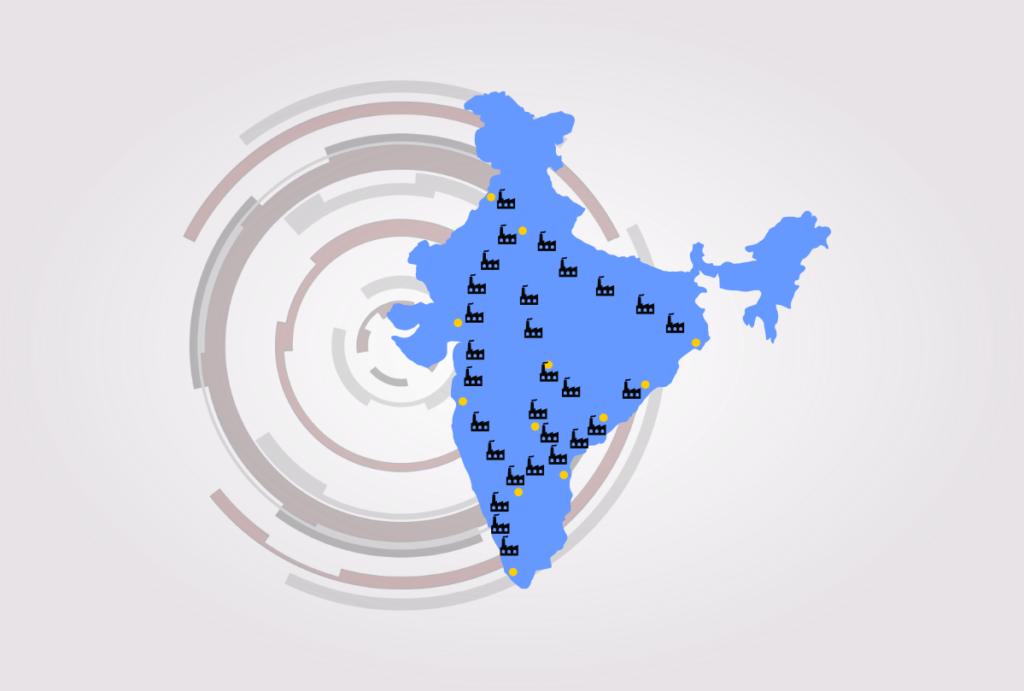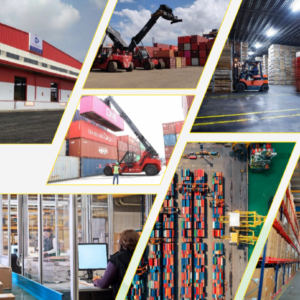
Industrial Corridors are an integration of Industrial growth and Infrastructure development as different constituents of any Economy are interlinked and rely on each other for their growth. As piecemeal and unplanned development of each of such sectors has and will only lead to imbalance and inefficiency in the economy, a planned and integrated development of these sectors is necessary.
Components of Infrastructure in Industrial Corridors:
To support industries, the Industrial corridors are being planned to provide suitable infrastructure. The components of which are :
- Road Networks
- Rail Connectivity
- Airports with modern facilities
- Ports with modern capabilities
- Logistical support like: Logistic Parks and Transhipment hubs
- Townships and other infrastructure to support human resources
- Knowledge parks to facilitate the industries
Government of India has approved 11 Industrial Corridors comprising 32 projects and their development will be implemented through the National Industrial Corridor Development and Implementation Trust (NICDIT). These corridors are spread across India, with strategic focus on inclusive development to provide a boost to industrialization and planned urbanization. Smart cities are being developed along these corridors. These cities, with state-of-the-art infrastructure, will house the new workforce that is required to power manufacturing, in turn leading to planned urbanization.1
National Industrial Corridor projects are getting developed on the overall framework of PM GatiShakti – National Master Plan to provide a systematic, multi modal connectivity to various economic zones for a seamless movement of people, goods and services resulting in efficient conduct of logistics and economic activities.
This will help India become a strong entity in the Global Value Chain and enhance its competitiveness in manufacturing.
The 11 Industrial Corridors are as follows:
I. Delhi-Mumbai Industrial Corridor (DMIC)
DMIC is a US$ 90 billion mega infra project that covers an overall length of 1483 km between Delhi and Mumbai funded by the Government of India, Japanese loans, investments by Japanese firms and through Japan depository receipts issued by Indian companies 2
National Industrial Corridor Development Corporation (NICDC) Limited has been incorporated to establish, promote and facilitate the development of the DMIC project. It undertakes and assists project development services, for various central government agencies and state governments, relating to investment regions/industrial areas/economic regions/industrial nodes and townships3
The corridor will have 24 investment regions in eight manufacturing cities in Phase 1 of the project. The five cities that have been chosen in Phase 1 as Investment Regions are:
- Manesar – Bawal (Haryana)
- Dadri – NOIDA – Ghaziabad (Uttar Pradesh)
- Ahmedabad – Dholera (Gujarat)
- Pithampur – Dhar – Mhow (Madhya Pradesh)
- Khushkhera – Bhiwadi – Neemrana (Rajasthan)
The three cities that have been chosen as Industrial Areas are:
- Shendra – Bidkin (Maharashtra)
- Dighi Port (Maharashtra)
- Jodhpur – Pali – Marwar (Rajasthan)
Major 10 projects under this are:-
Under Implementation
- Dholera Special Investment Region (DSIR), Gujarat
- ShendraBidkin Industrial Area (SBIA), Maharashtra
- Integrated Industrial Township – Greater Noida (IIT-GN), Uttar Pradesh
- Integrated Industrial Township – VikramUdyogpuri (IIT-VUL), Madhya Pradesh
- Integrated Multi-Modal Logistics Hub – Nangal Chaudhary, Haryana
- Multi-Modal Logistics Hub & Multi-Modal Transport Hub (MMLH & MMTH), Uttar Pradesh
Project development activities underway
- Dighi Port Industrial Area, Maharashtra
- Multi-Modal Logistics Park, Sanand, Gujarat
- Jodhpur PaliMarwar Industrial Area, Rajasthan
- Khushkhera BhiwadiNeemrana Industrial Area, Rajasthan
II. Amritsar-Kolkata Industrial Corridor (AKIC)
The Amritsar-Kolkata Industrial Corridor (AKIC) Project extends from Amritsar (Punjab) to Dankuni (West Bengal). The AKIC will have an influence area across seven Indian states – Punjab, Haryana, Uttar Pradesh, Bihar, Jharkhand and West Bengal. The length of the Amritsar-Kolkata Industrial Corridor (AKIC) is 1839 km.
Following seven Integrated Manufacturing Clusters (IMCs) have been identified:
- Rajpura-Patiala (Punjab)
- Prag-Khurpia Farms (Uttarakhand)
- Bhaupur (Uttar Pradesh)
- Gamhariya (Bihar)
- Barhi (Jharkhand)
- Raghunathpur (West Bengal)
- Hisar (Haryana)
III. Chennai-Bengaluru Industrial Corridor (CBIC)
The Chennai Bengaluru Industrial Corridor (CBIC) has been Proposed to achieve accelerated growth, regional industry agglomeration in the states of Tamil Nadu, Karnataka and Andhra Pradesh, and to facilitate the development of a well-planned and efficient industrial base.
The industrial corridor will achieve the goal by providing smooth access to industrial production units, reducing transportation logistic costs and improving delivery time as well as decreasing inventory cost. This will ensure increased private investments in manufacturing and industrial activity in the three states.
The Japan International Cooperation Agency (JICA) study team conducted a preliminary study for the Comprehensive Integrated Master Plan of the CBIC. The study team identified 25 priority projects, across various sectors, that aim to remove infrastructural bottlenecks in the project.4
IV. Extension of CBIC to Kochi via Coimbatore
NICDIT has given its approval for the extension of the CBIC project to Kochi via Coimbatore.
Two nodes have been identified for further development:
- Palakkad (Kerala)
- Dharmapuri (Tamil Nadu)
V. Bengaluru-Mumbai Industrial Corridor (BMIC)
The Bengaluru Mumbai Industrial Corridor (BMIC) is intended to facilitate the development of a well-planned and resource-efficient industrial base served by world-class sustainable connectivity infrastructure, bringing significant benefits in terms of innovation, manufacturing, job creation and resource security. The BMEC will be spread across Karnataka and Maharashtra.
Major 2 projects under this are:-
Project development activities underway
- Dharwad Node, Karnataka
- Satara Node, Maharashtra
VI. Hyderabad Nagpur Industrial Corridor (HNIC)
The Hyderabad Nagpur Industrial Corridor (HNIC) has an influence area spread across the states of Telangana and Maharashtra. Strong connectivity through rail, road and airways will help in boosting industrial growth.5
Major project under this:-
- Zaheerabad Phase I, Telangana
VII. Hyderabad Warangal Industrial Corridor (HWIC)
The Hyderabad Warangal Industrial Corridor (HWIC) has an influence area spread across the states of Telangana and Maharashtra. It will facilitate the development of a well-planned and resource-efficient industrial base that will bring innovation, manufacturing and job creation.
Hyderabad Phase I, Telangana project is identified under this.
VIII. Hyderabad Bengaluru Industrial Corridor (HBIC)
The Hyderabad Bengaluru Industrial Corridor (HBIC) will have an influence area spread across three states- Telangana, Andhra Pradesh and Karnataka. HBIC is an extension of Hyderabad Nagpur Industrial Corridor (HNIC) with an objective to connect central parts of the country with southern parts. The following node has been identified for development in the initial phase:
- Orvakal Node
IX. Vizag-Chennai Industrial Corridor (VCIC)
Vizag Chennai Industrial Corridor (VCIC) is the first coastal economic corridor in the country. It is part of the East Coast Economic Corridor (ECEC). VCIC region has one of the largest concentrations of industrial, mineral and urban nodes. It covers more than 800 km of Andhra Pradesh’s coastline and is aligned with the Golden Quadrilateral.
Major 3 projects under this are:-
Project development activities underway
- Koparthy Industrial Area, Andhra Pradesh
- Visakhapatnam Industrial Area, Andhra Pradesh
- Chitoor Industrial Area, Andhra Pradesh
X. Odisha Economic Corridor Economic Corridor (OEC)
Odisha Economic Corridor will be developed as a part of the East Coast Economic Corridor.
The following 2 nodes have been identified for development:
- Gopalpur-Bhubaneshwar-Kalinganagar (GBK)
- Paradip-Kendrapada-Dhamra-Subarnarekha (PKDS)
XI. Delhi Nagpur Industrial Corridor (DNIC)
Delhi Nagpur Industrial Corridor (DNIC) will spread along the North-South corridor of dedicated freight corridors (DFC) and on the existing NH network. Dedicated Freight corridors are being developed by the Ministry of Railways. Currently, the following DFC’s are in an advanced stage of completion:
- Eastern dedicated Freight Corridor (Ludhiana to Dankuni)
- Western dedicated Freight corridor (JNPT/Mumbai to Dadri)





